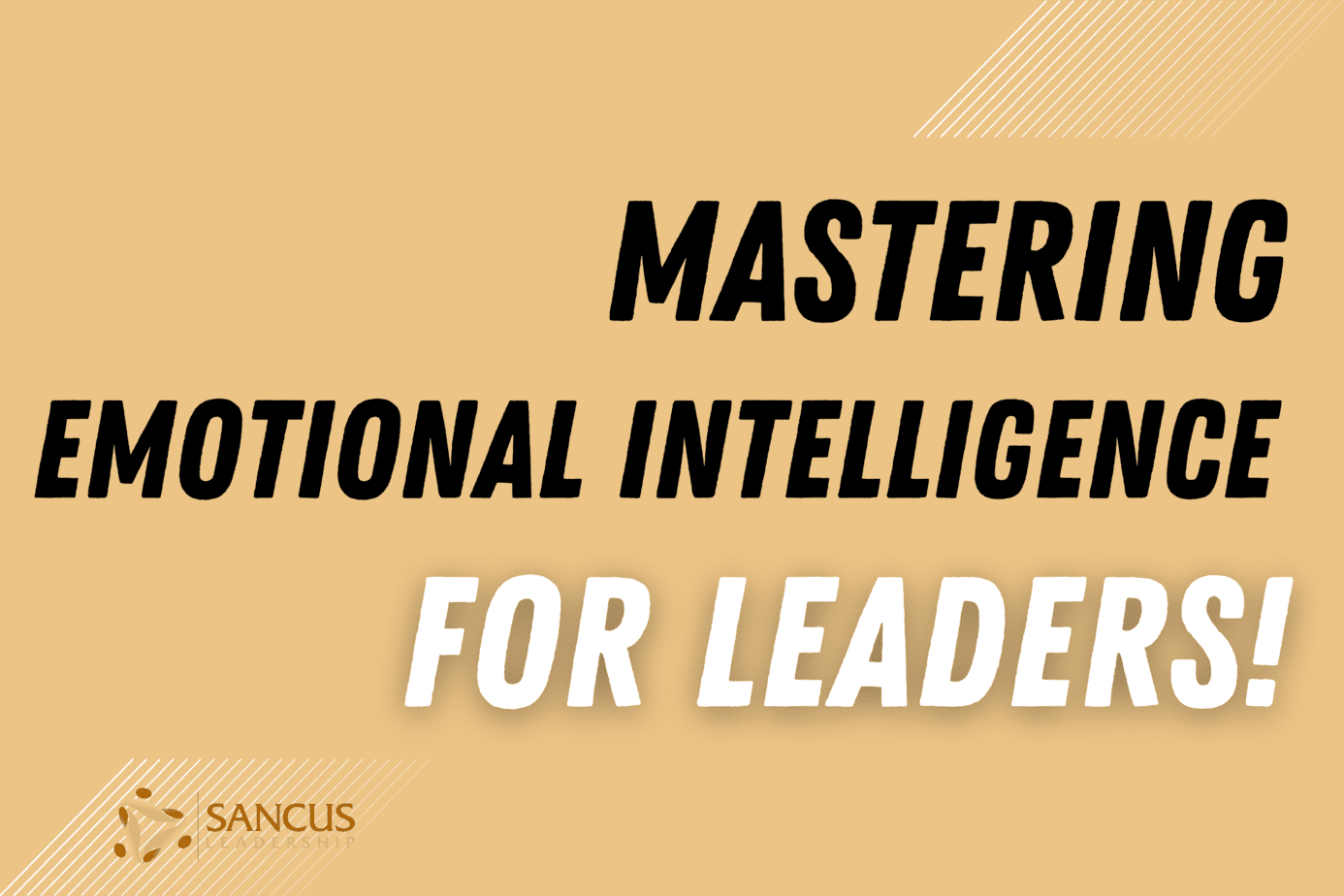When I started my military leadership career, I thought emotions weren’t part of the equation; I thought the best leaders could set aside their emotions and only look to the facts. With over 13 years of leadership experience in every arena, from sports to youth education to military deployments, I now know I couldn’t have been farther from the truth. Self-management and emotional intelligence help managers increase their empathy, lead with compassion, and work together toward common goals.
Self-management in emotional intelligence is a person’s ability to regulate behaviors triggered by emotions. It involves being aware of your motivations and dispositions, then choosing better responses to emotional triggers. Leaders can then apply these principles in small group settings.
This article will explore what it means to manage your emotional intelligence. I’ll also discuss building, leading, and managing teams with emotional intelligence in mind. Along the way, we’ll cover the role of neuroplasticity and how to form new habits.
What Is Emotional Intelligence?

Emotional quotient, or EQ for short, is a person’s emotional intelligence level. Two psychology professors first mentioned emotional Intelligence, or EI for short, in a 1990 research paper. Then in 1998, Rutgers psychologist Daniel Goleman wrote an article that equated good business leadership with high emotional Intelligence.
Emotional Intelligence means being aware of your own emotions and the emotions of others and then using that information to understand and manage emotional signals. It helps people know themselves better and develop empathy in interpersonal relationships.
Why Emotional Intelligence Is Valued in the Workplace
The World Economic Forum listed key skills all employees will need by 2025. Many of these skills require a high level of emotional intelligence.
CareerBuilder surveyed that over 71% of employers value EQ over IQ. 61% went as far as to say they’d promote candidates with high emotional intelligence over those with high IQs. In other words, they would rather have employees who empathize and relate to people well than employees with only theoretical knowledge.
Specifically, the survey discovered employers found workers with high EQ to be good at the following five things.
- Staying calm under pressure
- Resolving conflicts
- Expressing empathy to other team members
- Leading by example
- Making thoughtful business decisions
These findings echoed President Theodore Roosevelt’s statement, “No one cares how much you know until they know how much you care.” Workplace environments generally rely on teamwork and managing several relationships within the organization. It’s no wonder understanding the feelings of those around you is considered a high-level skill needed for business success.
No one cares how much you know until they know how much you care.
CareerBuilder’s survey also found that HR recruiters and hiring managers assessed candidates’ emotional intelligence by considering if they possessed the following characteristics.
- They admit when they’re wrong.
- They can have tough conversations without getting too emotional.
- They’re good listeners.
- They can take criticism constructively.
- They remain composed in stressful situations.
With these skills, a team leader can manage employees more effectively.
- They’ll know how and when to express appreciation for hard work.
- They’ll understand how to create motivation and maintain enthusiasm in the group.
- They’ll recognize signs of burnout.
- Leaders will also know when to pivot and adapt to whatever changes come their way.
What Is Self-Management?

Self-management is the regulation of behaviors and thoughts to develop habits that will improve one’s life. Though emotions may be involved, it is less about emotion and more about taking action.
Here is a list of nine items someone may include in their self-management efforts.
- Time management
- Budgeting
- Health
- Career
- Education
- Adaptability
- Stress
- Motivation
- Decision making
Reading this Self-Management Article is a great way to improve your communication with your work so you get less questions and faster results!
How Do You Develop Self-Management in Emotional Intelligence?

You develop self-management in emotional intelligence by practicing better habits in empathy, teamwork, and leading by example. The process involves organizing your priorities and goals so you can transfer those skills to a team setting.
In essence, self-management in emotional intelligence is about developing good habits and breaking bad ones. You can then apply this process to your leadership style, personal life, and work.
How To Manage Yourself

Self-management begins with awareness and understanding your core motivations better. Often, people do not pay attention to their own “self-talk.” Changing how you view yourself is difficult. It means understanding you can’t always choose your circumstances, but you can always pick your response.
Changing how you view yourself is difficult. It means understanding you can’t always choose your circumstances, but you can always choose your response.
Self-management requires replacing bad habits with good ones. Neuroplasticity plays a massive role in this. It’s the idea that our brain cells change in response to behavior. Learning creates new connections between neurons, which strengthen with repetition.
The bad news is that behavior constantly reinforced through repetition is hard to change. The good news is that it’s not impossible.
New behaviors can be learned and practiced to form new connections. By stopping the behavior, old behaviors can be unlearned or weakened. Your brain remains a constant learning machine for the duration of your life.
A lot goes into the pursuit of developing better habits. Countless books are released on the subject every year. One of the more famous titles in this space is The 7 Habits of Highly Effective People. In it, author Stephen R. Covey lists the following habits as imperative to self-growth.
- Be Proactive
- Begin With the End in Mind
- Put First Things First
- Think Win/Win
- Seek First to Understand, Then to Be Understood
- Synergize
- Sharpen the Saw
Self-management is prioritizing, goal-setting, and replacing poor habits with better ones. Managers who expect to lead teams effectively must learn how to manage themselves first.
Managers who expect to lead teams effectively must learn how to manage themselves first.
The process of learning how to manage yourself begins with two simple principles.
1. Avoiding Bad Habits
According to Atomic Habits by James Clear, there are four things people need to do to break bad habits.
- Make It Invisible: In other words, figure out the environment and triggers enabling the bad habit. Do whatever you can to reduce your exposure to these bad habit cues.
- Make It Unattractive: Focus on what you gain by avoiding the bad habit. Highlight the benefits in your mind.
- Make It Difficult: Create steps between you and the bad habit, making it harder to reinforce.
- Make It Unsatisfying: Find someone to be accountable to so that the price of continuing the bad habit will be public and hurt more.
| How to Break Bad Habits | Description |
| Make It Invisible | Identify the environment and triggers that enable the bad habit and take steps to reduce your exposure to them. |
| Make It Unattractive | Focus on the negative consequences of the bad habit and the benefits of avoiding it. Use visualization techniques to reinforce the idea that the habit is unattractive. |
| Make It Difficult | Create obstacles or steps between you and the bad habit to make it harder to engage in. |
| Make It Unsatisfying | Find someone to be accountable to, such as a friend or mentor, who can help you stay motivated and hold you accountable for your actions. |
2. Forming Good Habits
Likewise, James Clear outlines four things people need to do to form good habits.
- Make It Obvious: Create an environment where the triggers for the good habit will be visible. Write down the time and location you will regularly engage in the new habit.
- Make It Attractive: You can do this by combining things you want to do with things you need to do. Joining a group where the desired habit is the norm will help reinforce your motivation.
- Make It Easy: Remove or reduce steps between you and the good habit. Use technology to automate habits. You can also prepare your environment to make the habit easier to maintain in the future.
- Make It Satisfying: Reward yourself immediately after completing the good habit. A reward will make the process more enjoyable. Utilize habit-tracking technology to stay motivated and to keep up with your progress.
| How to Form Good Habits | Description |
| Make It Obvious | Make the desired habit obvious by creating an environment where the triggers for the habit are visible. Write down the time and location to do it. |
| Make It Attractive | Make the habit attractive by combining things you want to do with things you need to do. Join a group that reinforces the desired habit. |
| Make It Easy | Make the habit easy by removing or reducing steps between you and the habit. Use technology to automate habits and prepare your environment. |
| Make It Satisfying | Make the habit satisfying by rewarding yourself immediately after completing it. Use habit-tracking technology to stay motivated and track progress. |
Self-management involves intentional habit-forming, prioritizing the right things, and setting goals. Habits take time to become automatic. One study found it took people anywhere from 18-254 days to form a habit. Whether you’re trying to budget your time or money, learn more, or advance in your career, it will take forming good habits and breaking bad ones to get there.
Whether you’re trying to budget your time or money, learn more, or advance in your career, it will take forming good habits and breaking bad ones to get there.
Here’s a YouTube clip by Andrew Huberman where you will learn how to make and break habits. It’s a long watch, but I can recommend it!
How To Lead Others With The Aid of Emotional Intelligence

Now that we’ve discussed emotional intelligence and self-management separately. Let’s take a look at what it means to apply the principles of self-management in emotional intelligence. This is a key skill business leaders need to master to manage their teams with maximum efficacy.
A supervisor or manager with high emotional intelligence will display the following qualities in their leadership style.
- Effective communication
- Understand the emotions of individuals on the team
- Understand the emotions of the group as a whole
- Can express their own emotions in healthy and helpful ways to the group
- Respect employees at all levels of the company
- Active listening to the concerns of others
- Navigate stressful and difficult situations with calm and resolve
- Maintain positive atmosphere
- Anticipate and prepare for staff reactions to disappointing news
- Make employees feel safe to share ideas and concerns
- Show appreciation for effective work
- Handle pressure well
- Empathize with customers
- Open to both good and bad feedback
- Resolve conflicts within the group fairly
- Inspire staff to achieve goals
- Possess empathy for employees at all levels
- Keep team motivated
The leader who displays these qualities will have a much easier time gaining the trust of those under their management. Once you earn their trust, employees are more likely to perform better at their jobs and work as a cohesive team with shared goals. Individuals and teams with high emotional quotient will likely enjoy their jobs more as well.
7 Steps To Building Small Teams With High EQ in Mind
Leaders of small teams of 2-10 people will want their team to operate as cohesively as possible. This can only be done with a high quotient of emotional intelligence. Let’s look at seven steps that you, as a leader, can take to transform your team’s culture for the better.
1. Normalize Empathy
First and foremost, there needs to be empathy. Employees need to feel understood to offer their full potential. Leaders need to understand their teams contain many individuals. These individuals have personal lives apart from the team. These lives have their problems, stresses, and issues separate from the group.
Employees need to feel understood to offer their full potential.
Managers with developed listening skills will win the trust of their employees faster than those who do not. This is especially true when leaders have the additional skill set to increase their sense of humanity in the employees under them and not treat them like cogs in a machine.
Managers who empathize with their employees and offer appropriate accommodations are likelier to build a healthy, positive work environment.
2. Normalize Appreciation
Practical work should always be noticed. Managers need to habitually and publicly show appreciation for the EFFECTIVE work of individuals on the team and the group as a whole. Even if certain positions are technically disposable, the people who fill those positions should be treated as such.
Rewarding the type of work you want to see more of you is essential. If you reward hard work, you will likely get more people working hard, i.e., people will do more extended hours, but it is not sure that the impact on revenue is more significant.
Instead, if you choose to reward practical work, that is, not caring how hard people work but rather focusing on the output they should achieve, aka how effective they are. Then you’ll likely see a bump in revenue and a drop in sick leaves (fewer overworked employees).
…if you choose to reward effective work instead of hard work … you’ll likely see a bump in revenue and a drop in sick leaves.
3. Normalize Idea Sharing
In addition to employees needing to feel understood and valued, they also need to feel heard. Leaders should create a safe environment for employees to share their ideas for the organization. This space may come in the form of a brainstorming session. Whenever possible, leaders should implement employee ideas.
Make sure you attribute the ideas to the person or the team that created them!
4. Normalize Collective Goals
For a group of people to become a team, they need a common goal to work towards. Managers may find it helpful to incentivize reaching quotas. They can do this with friendly competitions with other groups in the department or within the group itself. Leaders should think creatively about group rewards when the group achieves its targets.
The main focus should be to form inner drive and intrinsic motivations; we have known since the 70s that external incentives, such as money, only work if the task is simple. It only improves outcomes if the job is simple and creative.
5. Normalize Adaptability
Adaptability will mitigate a significant change’s negative impact on a group. With improving technologies and changing work habits, many companies frequently go through periods of change. Group leaders need to prepare their employees to pivot when required routinely.
6. Make Constructive Feedback a Routine
Remember that feedback is not the same as criticism. There is a negative connotation to the latter. When an employee’s poor performance in a given area needs to be addressed, leaders should have a system to normalize giving feedback with improvement steps to take.
The feedback process should be about helping employees identify where they need to improve and providing the framework to do so. It should not be about publicly tearing down the employee.
7. Normalize Group Socialization
This one may be harder to maintain in your group’s culture. However, you can organize outings and events to allow your team to get to know one another away from the work setting. Friendships and bonds can strengthen the group’s interpersonal relationships.
These seven steps will help boost team morale while creating a group culture where individuals feel valued. We as leaders must first engage in self-management in our personal lives to know how to steer our team toward higher emotional intelligence.

The Cost of Low Emotional Intelligence
The reason high emotional intelligence is so crucial in the workplace is twofold. First, there are many benefits of high emotional intelligence. However, having a team low on emotional intelligence also has many costs.
When a leader, a small group, or a business team suffers from low emotional intelligence, the following may be characteristic of the group.
- Lack of socialization with fellow team members
- Being critical of others
- Little empathy
- Not handling stress or pressure well
- Ineffective communication
- Unable to take criticism constructively
- Not respecting the perspective or concerns of others
These traits can bring team spirit and morale down. There will be less trust between staff and leadership. The group will be less likely to work hard towards common goals.
Final Thoughts
There’s no such thing as successfully developing yourself or your team without scoring high in emotional intelligence. Being aware of and sensitive to your own emotions and the emotions of those around you will serve you and your group well.
Self-management in emotional intelligence is more than just a tool or strategy for leaders to implement in their private and professional lives. It means living and leading with the empathy and awareness required to make sound decisions that benefit everyone involved. It takes the discipline of good habits, compassion, and, most of all, deliberate practice.



